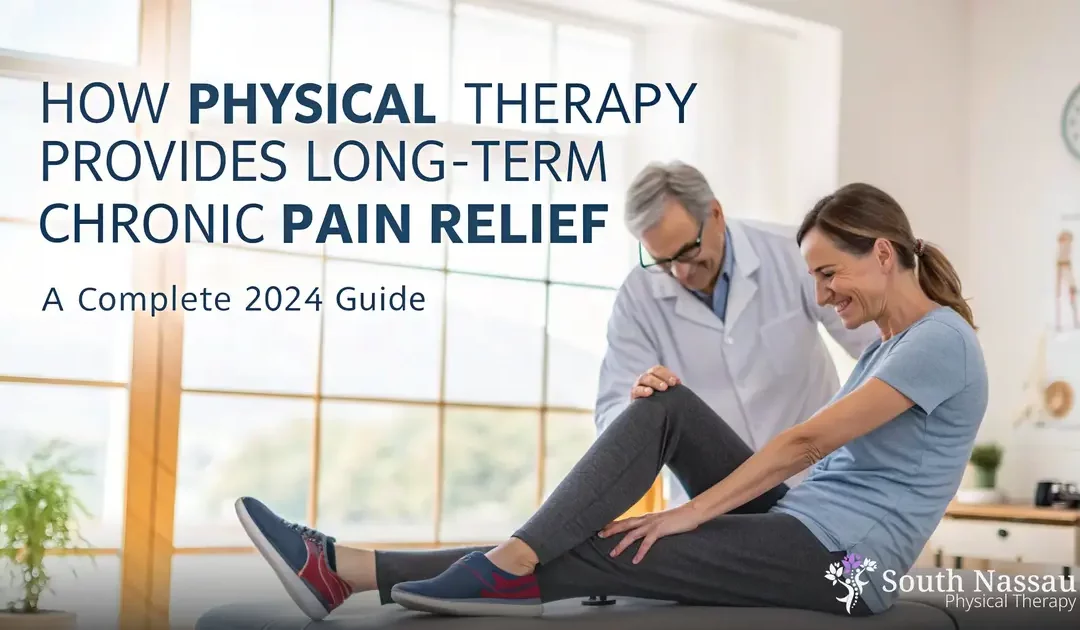How Physical Therapy Provides Long-Term Chronic Pain Relief: A Complete 2024 Guide
Introduction
Living with chronic pain can feel overwhelming, affecting every aspect of daily life, from work and hobbies to quality time with loved ones. Did you know that over 20% of adults in the United States live with chronic pain? That’s nearly one in every five people. Thankfully, there’s hope and a proven path forward: chronic pain relief through physical therapy.
Whether you’re managing arthritis, recovering from surgery, or dealing with persistent back pain, physical therapy offers customized solutions that target the root of the problem. In this guide, we’ll explore the transformative potential of physical therapy, breaking down the why, how, and what of this effective chronic pain treatment.
Understanding Chronic Pain and Its Impact
What Is Chronic Pain?
Chronic pain is pain that lasts for more than three months, persisting beyond the healing phase of an injury or health condition. It can manifest in different forms, such as:
- Neuropathic pain (nerve damage)
- Muscular pain (myofascial pain syndrome)
- Joint pain (arthritis)
How Does Chronic Pain Affect Daily Life?
Chronic pain can significantly disrupt physical and emotional well-being. You may feel:
- Limited mobility
- Increased fatigue
- Decreased ability to enjoy daily activities, like walking or cooking
It can also lead to anxiety or depression, creating a cycle where pain and mood disorders exacerbate one another.
Common Causes of Chronic Pain
Some common conditions linked to chronic pain include:
- Arthritis
- Chronic back and neck pain
- Fibromyalgia
- Post-surgical pain
Early intervention is key to avoiding further complications. The sooner you seek help, the quicker you can take control of your life again.
How Physical Therapy Addresses Chronic Pain
Initial Assessment and Treatment Planning
Physical therapy begins with a personalized evaluation. A licensed therapist will assess your range of motion, pain points, and medical history to create a treatment plan tailored to your needs. This plan adapts over time as you progress in your recovery.
Evidence-Based Techniques for Pain Management
Physical therapists use proven therapeutic techniques, such as:
- Manual therapies, including massage and joint mobilization
- Functional exercises tailored to your condition
- Modalities like heat, cold, or electrical stimulation
Movement: A Powerful Pain Reliever
Engaging in safe and controlled movement is often the cornerstone of pain management therapy. Gentle, guided exercises can:
- Strengthen muscles around pain-affected areas
- Improve flexibility and mobility
- Reduce inflammation and stiffness
For older adults, specific pain management strategies focus on reducing risk factors for injury and improving overall balance.
Effective Physical Therapy Techniques for Pain Management
Manual Therapy and Massage
Hands-on techniques like therapeutic massage improve blood flow and reduce muscle tension. These methods not only relieve pain but also enhance mobility.
Targeted Stretching and Strengthening Exercises
Target-specific exercises are designed to:
- Mitigate discomfort caused by muscle imbalances
- Gradually improve your body’s range of motion
Joint Mobilization Techniques
For joint issues, mobilization therapy focuses on improving alignment and reducing stiffness. By carefully manipulating the joints, therapists help restore natural movement patterns.
Hot and Cold Therapy
Using heat packs to soothe stiff muscles or ice to reduce swelling is a simple but effective approach.
Specialized Treatment Programs for Different Pain Types
Back and Neck Pain Management
Proper posture exercises, spinal stretching, and core strengthening can effectively reduce pressure on your back and neck.
Arthritis and Joint Pain Relief
Low-impact therapeutic movements help enhance joint flexibility, making everyday tasks easier and less painful.
Post-Surgical Pain Treatment
For those recovering from surgery, physical therapists use gradual techniques to restore strength and mobility safely while speeding up healing.
Chronic Muscle Pain Solutions
Muscle pain caused by overuse or poor posture can respond well to myofascial release therapy, improving both comfort and function.
Long-Term Benefits and Success Stories
Real Patient Testimonials
At South Nassau Physical Therapy, patients have shared incredible recovery stories, such as:
- Regaining full function after knee surgery
- Alleviation of chronic back pain to return to their active lifestyle
Research-Backed Results
Studies consistently confirm the effectiveness of physical therapy. For example:
- A 2023 study showed 85% of patients experienced significant improvements in pain management after consistent therapy sessions.
Improving Quality of Life
Beyond pain relief, physical therapy supports:
- Restored independence
- Enhanced physical comfort
- Renewed mental well-being
Tips for Maintaining Progress
- Follow prescribed home exercise routines
- Stick to your follow-up appointments
- Set realistic goals for continued improvement
Getting Started with Physical Therapy for Pain Relief
What to Expect in Your First Session
Your first visit typically involves:
- A detailed assessment of your needs
- Setting personalized recovery goals
- Receiving a treatment plan designed specifically for you
Insurance and Payment Options
Physical therapy services are often covered by insurance. Be sure to check with your provider beforehand or contact us for guidance.
Preparing for Your Appointment
Wear comfortable clothing that doesn’t restrict your movement, and bring any relevant medical records or imaging (if applicable).
Creating a Sustainable Treatment Plan
Recovery doesn’t stop when the session ends. You’ll be provided with homework exercises and lifestyle tips to maximize long-term results.
Conclusion
Chronic pain doesn’t have to control your life—but managing it requires taking the first step. Physical therapy is a proven, effective way to reduce pain, restore function, and get back to the activities you love.
At South Nassau Physical Therapy, we’re ready to support your journey every step of the way. Let’s create a customized treatment plan to help you feel your best.
Take action today. Start your recovery journey by scheduling a consultation with us. Together, we’ll work toward reclaiming your strength, mobility, and freedom.

